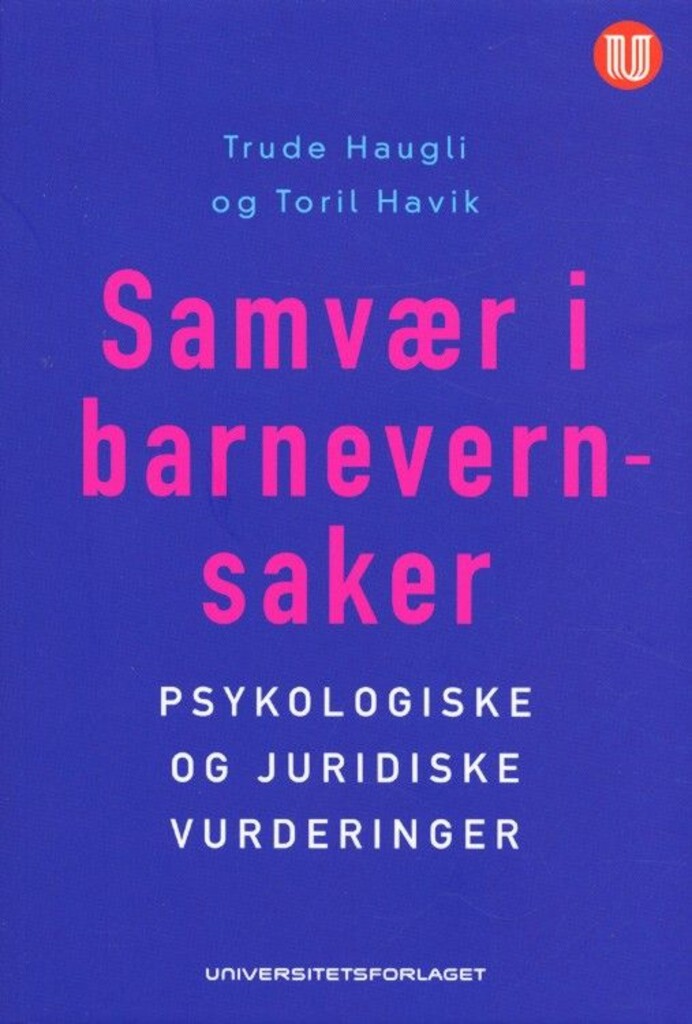
Samvær i barnevernsaker : psykologiske og juridiske vurderinger
Trude Haugli
Bok · Bokmål · 2010
| Medvirkende | |
|---|---|
| Utgitt | Oslo : Universitetsforl. , cop. 2010
|
| Omfang | 169 s.
|
| Opplysninger | Elektronisk reproduksjon
|
| Emner | Child Custody
Child Welfare Divorce Legislation Vis mer... Parent-Child Relations
Child Care Children-at-risk Childrens rights International law Psychology Social services barnevern samvær lover psykologi jus barnevernsloven samværsrett norge lov rett barn rettigheter foreldre fosterhjem adopsjon |
| Geografisk emneord | |
| Dewey | |
| ISBN | 9788215016450 : Nkr 279.00
|
- Askerbibliotekene: Asker bibliotek har 1 av 1 ledig
- Bærum bibliotek: Hovedbiblioteket Bekkestua har 1 av 1 ledig
- Deichman Bjørvika har 0 av 1 ledig
- Departementenes sikkerhets- og serviceorganisasjon: Departementenes bibliotek har 1 av 1 ledig
- Høgskolen i Molde: Biblioteket har 1 av 1 ledig
- Høgskolen i Østfold: Biblioteket - Fredrikstad har 3 av 3 ledig
- Høgskulen i Volda: Biblioteket har 1 av 1 ledig
- Høgskulen på Vestlandet: Biblioteket Bergen har 1 av 2 ledig
- Høgskulen på Vestlandet: Biblioteket Stord har 1 av 1 ledig
- INN: Universitetsbiblioteket Elverum har 1 av 1 ledig
- INN: Universitetsbiblioteket Lillehammer har 1 av 1 ledig
- Justis- og beredskapsdepartementet: Biblioteket har 0 av 0 ledig (Oppdaterer)
- Kriminalomsorgens høgskole og utdanningssenter KRUS: Biblioteket har 1 av 1 ledig
- Mangfolds- og migrasjonsbiblioteket har 1 av 1 ledig
- Nasjonalbiblioteket: Depotbiblioteket har 2 av 2 ledig
- Nord universitet - Universitetsbiblioteket Bodø har 2 av 2 ledig
- NTNU Universitetsbiblioteket: Biblioteket Dragvoll har 1 av 1 ledig
- NTNU Universitetsbiblioteket: Biblioteket Øya har 1 av 1 ledig
- Politihøgskolen: Biblioteket har 1 av 1 ledig
- Rana bibliotek har 1 av 1 ledig
- Sandefjord bibliotek har 1 av 1 ledig
- Sølvberget bibliotek og kulturhus har 1 av 1 ledig
- Tromsø bibliotek og byarkiv: Hovedbiblioteket har 1 av 1 ledig
- Tønsberg og Færder bibliotek: Hovedbiblioteket har 1 av 1 ledig
- UiO : Universitetsbiblioteket: HumSam-biblioteket har 0 av 1 ledig
- UiO : Universitetsbiblioteket: Juridisk bibliotek har 5 av 5 ledig
- UiT Norges arktiske universitet: Altabiblioteket har 2 av 2 ledig
- UiT Norges arktiske universitet: Harstadbiblioteket har 1 av 1 ledig
- UiT Norges arktiske universitet: Natur- og helsefagbiblioteket har 1 av 1 ledig
- UiT Norges arktiske universitet: Psykologi- og jusbiblioteket har 2 av 2 ledig
- Universitetsbiblioteket i Agder: Grimstad har 1 av 1 ledig
- Universitetsbiblioteket i Agder: Kristiansand har 1 av 1 ledig
- Universitetsbiblioteket i Bergen: Bibliotek for samfunnsvitenskap, musikk og psykologi har 1 av 1 ledig
- Universitetsbiblioteket i Stavanger: Ullandhaug har 1 av 1 ledig
- Universitetsbiblioteket i Sørøst-Norge: Biblioteket - Drammen har 1 av 1 ledig
- Universitetsbiblioteket i Sørøst-Norge: Biblioteket - Porsgrunn har 3 av 3 ledig
- VID vitenskapelige høgskole, studiested Oslo har 1 av 1 ledig
- VID vitenskapelige høgskole,: studiested Stavanger har 1 av 1 ledig